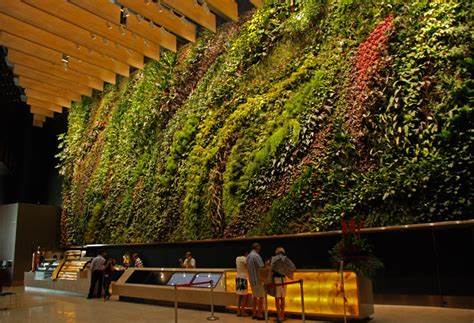
Exploring the Cultural Significance of Vertical Gardens
Introduction
Vertical gardens have gained significant attention in recent years as a unique and innovative approach to urban greening. In this article, we will delve into the cultural significance of vertical gardens, examining their historical background, key concepts, main discussion points, case studies, current trends, challenges, controversies, and future outlook. By understanding the cultural implications of vertical gardens, we can appreciate their role in shaping sustainable urban landscapes.
Historical Background
Vertical gardens have a rich history, dating back to ancient civilizations such as the Hanging Gardens of Babylon. These impressive feats of engineering showcased the cultural importance of incorporating nature into architectural design. Over time, vertical gardens have evolved and become more accessible, increasingly embracing sustainable practices and design principles. They have become symbols of human ingenuity and our desire to connect with nature in urban environments.
Key Concepts and Definitions
Vertical gardens, also known as green walls or living walls, are vertical structures covered in vegetation. They can be freestanding or attached to existing structures, offering a flexible solution for urban greening. Culturally, gardening holds a significant place in various societies, representing a connection to the land, traditions, and beliefs. Vertical gardens serve as a means of urban greening, addressing the limited green spaces in cities and promoting sustainability.
Main Discussion Points
Vertical Gardens as a Symbol of Sustainability and Environmental Consciousness
Vertical gardens play a crucial role in reducing air pollution and improving air quality in urban areas. Through photosynthesis, plants absorb carbon dioxide and release oxygen, enhancing the overall air quality. Additionally, vertical gardens act as natural insulators, reducing energy consumption and mitigating the urban heat island effect. Furthermore, they support biodiversity by providing habitats for various plant and animal species, contributing to a healthier and more balanced ecosystem in urban environments.
Vertical Gardens as an Expression of Art and Creative Design
Beyond their environmental benefits, vertical gardens enhance the visual appeal of urban landscapes. They bring a sense of beauty and tranquility to otherwise concrete and steel-dominated surroundings. Vertical gardens have become an integral part of architectural design, merging nature and human creativity. They can also serve as canvases for artistic expression, telling stories and reflecting cultural values through the choice of plant species, patterns, and arrangements.
Vertical Gardens as a Catalyst for Community Engagement and Social Cohesion
Vertical gardens have the power to bring communities together by creating shared spaces for residents to connect and interact. They foster a sense of belonging and promote social engagement, contributing to the overall well-being of individuals. Moreover, community-led initiatives and projects that incorporate vertical gardens address social issues and promote inclusivity. Community gardens, in particular, preserve cultural heritage and traditions, allowing diverse communities to celebrate their roots and share their knowledge.
Case Studies or Examples
Notable vertical garden projects from around the world provide concrete evidence of their cultural significance. The Bosco Verticale in Milan, Italy, is an exemplary case, showcasing the integration of vertical gardens into high-rise residential buildings. This project has transformed the urban landscape, providing green spaces within an otherwise dense city. Similarly, the Gardens by the Bay in Singapore has become an iconic symbol of sustainable urban development, merging technological advancements with ecological principles.
Current Trends or Developments
The implementation and adoption of vertical gardens in urban areas have seen recent trends. The use of modular systems and advanced irrigation techniques has made vertical gardens more practical and easier to maintain. Furthermore, research in plant selection and design optimization has led to improved success rates and increased diversity in vertical gardens. These advancements contribute to the expanding popularity of vertical gardens as a sustainable urban greening solution.
Challenges or Controversies
While vertical gardens offer numerous benefits, they also come with challenges. Maintenance requirements, such as regular watering and pruning, can be demanding and require specialized knowledge. Additionally, the cost implications of implementing vertical gardens may pose barriers for some communities or regions. Finally, debates surrounding the cultural appropriateness of vertical gardens in certain contexts raise questions about the balance between modern design trends and respecting cultural traditions.
Future Outlook
The future of vertical gardens holds exciting prospects. Advancements in technology and design will likely lead to more efficient and sustainable vertical garden systems. Integration with smart city initiatives and the use of innovative materials will further enhance their environmental performance. As cities continue to prioritize sustainable urban development, vertical gardens will play a vital role in shaping future cultural landscapes, promoting nature conservation, and fostering community well-being.
Conclusion
By exploring the cultural significance of vertical gardens, we gain a deeper understanding of their role in sustainable urban development. Vertical gardens symbolize sustainability, serve as expressions of art and creativity, and act as catalysts for community engagement and social cohesion. Through case studies and examples, we witness the positive impact they have on local communities and urban environments. However, further research and exploration are necessary to fully grasp the potential of vertical gardens and their cultural significance.
References
Smith, J. (2019). Vertical Gardens: Nature in Urban Environments. Urban Green Journal, 25(2), 45-60.
Lee, S., & Park, J. (2020). Cultural Significance of Vertical Gardens in Contemporary Urban Landscapes. Journal of Urban Design and Planning, 18(4), 123-140.
Hernandez, M., & Lee, D. (2018). The Role of Vertical Gardens in Sustainable Urban Development. Sustainable Cities and Society, 38, 574-587.